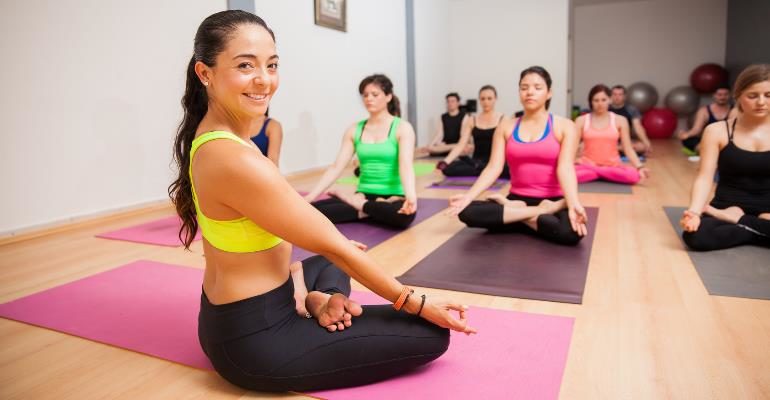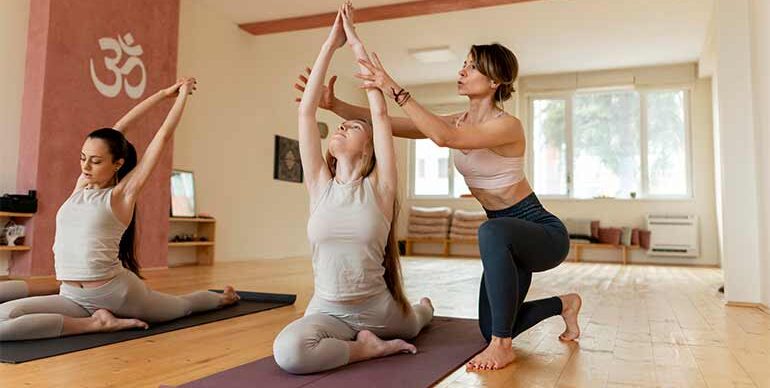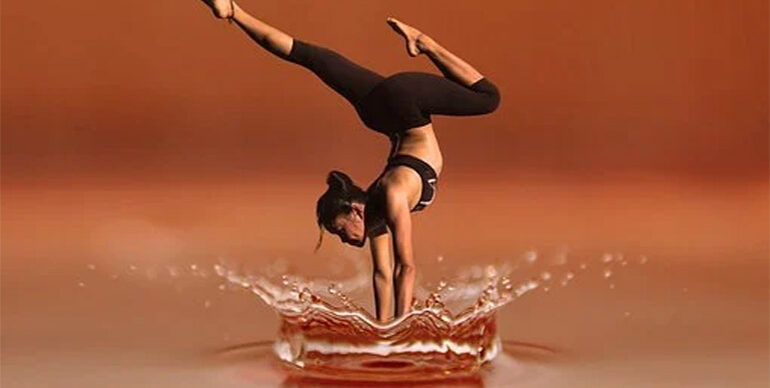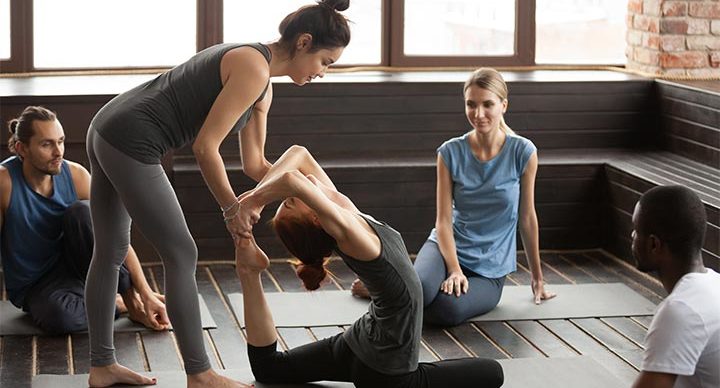
As Mumbai and Delhi’s premier Yoga Consultancy and yoga studio, we get approached by lots of young, enthusiastic and vibrant yoga trainers who have just done their Yoga Teachers Training Course and are raring to teach. If you are a yoga trainer just starting out or intending to start teaching soon, then this post is for you! Read the below tips on conducting a yoga class and take away whatever tips you can in order for you to inculcate best practises and watch your fan following grow!
-
Giving out Instructions
Teaching poses is alright for newbie yoga trainers but as one becomes more experienced in teaching a yoga class, refining and distilling instructions is the key. New Yoga teachers may be happy giving standard instructions to regular yoga poses. The chances are high that as a teacher one might be giving the same instructions that one has heard repeated by one’s teacher in Yoga Teacher Training Programs. These instructions may become stale and become boring both to you and your class.
A better way to give instructions to a class of students is to look at the pose the way the class is doing it and instruct the class or student accordingly. A class for beginner’s yoga may need detailed instructions on how to achieve the Warrior Pose 1. A more advanced yoga class may just need reminders to move the shoulders away from the ears or some prodding to enter into the pose in a deeper way.
Another way to keep everyone’s interest levels high is to teach the same pose in a different manner. It is not necessary to talk through each and every pose. It is not required to say everything one knows about a pose to the student. It is far more effective if the yoga teacher gives an instruction and gives some time to the student to process and internalize it while he / she is doing the pose.
But this does not mean that one should not give any instructions to an advanced yoga class. Every yoga pose has that one crucial instruction that must be given out. For standing yogasanas it will include instructions about the base of the pose, feet placement, knees and spine. For Utkatasana for example your instructions will be,’Your feet and knees are touching or close together and parallel. Your knees are pointed and aligned with your ankles. For Mountain Pose / tadasana your instructions will be, ‘Your feet are touching each other or are parrallel. Focus your attention on the 4 corners of your feet – big toe pad, small toe pad, inside and outside of heel. Press all 4 points on the floor and create a higher arch.’ Beginner students of Yoga will need these cues whereas advanced students will need to be reminded of them from time to time.
-
Teach Yoga – Do not Do Yoga
Samiksha our yoga teacher in Delhi is always fond of saying – As a yoga teacher, your attention must be on the class and your students. That will not happen if you are performing all the asanas yourself along with the class or your student. Trying to hold an asana and then explaining the asana to the class and finally watching the class do the asana at the same time is a lot more difficult than demonstrating and watching the class do the pose.
A lot of experienced yoga teachers will do the entire class along with their students but that comes with a disadvantage. This could be a habit that they would have picked up in their early years as a yoga instructor. It is actually quite easy for a yoga trainer to perform an asana and and also instruct students about what they themselves are doing and how they are feeling. But as a yoga trainer gains more experience this may be unnecessary. If you spend less time on your own poses, you will be able to observe and correct students. You will be better placed to evaluate the abilities of your student / students and adjust the poses if required. This way your students will also over time become more independent of you.
-
Keep Some Distance
A Yoga class is an escape from routine concerns. So your yoga class should be focused only on Yoga and not on any issues of your students and certainly not your own issues. A good yoga instructor will avoid talking about his / her personal problems, politics or any topic that is unrelated to Yoga. Many yoga teachers have lost their jobs at yoga studios or have lost lucrative personal training contracts over this issue! If you are a personal yoga trainer, you are not being hired to hold forth on your own problems or gossip. It is alright to interact with students after class or after a personal training session is done. But talking about personal issues with students even after class is not alright. There is no need to give information about yourself to your clients and students about stuff they would rather not know.
-
Class Control
Normally most students who attend yoga classes or clients who hire a personal yoga trainer, are disciplined but there are times when disruptive situations can happen. There are people who may want to talk during class either aloud or with other students. This is a practise that must not be encouraged. Something like this can disrupt the mood of a class and makes it hard for others to hear you properly. Then there are the occasional students who may grunt or groan loudly, laugh loudly or ask too many questions. Again you cannot act as a school teacher in such cases and send students out of the class. It is best to deal with such behaviour gently but affirmatively and using positive cues and stressing on why maintaining silence and decorum in a yoga class is for the benefit of all. Some yoga trainers hand out a sheet of paper that contains class etiquette behaviour that is expected from a teacher’s students. This is a very helpful and professional tip that can prevent many untoward and negative experiences from happening because you are setting the expectations right from the very beginning.
-
Using Your Voice
A yoga trainer’s voice is a very important tool in her / his arsenal of teaching. It is the most important and powerful way to communicate with students. A yoga trainer’s voice is a reflection of his / her attitude. Always present a mature and confident tone of voice that reflects respect for the students and respects them as intelligent human beings. Your tone cannot be too sing-song or bubbly in which case it may sound like you are talking to kids. The tone of your voice should be enthusiastic, inspiring and confident but yet friendly and kind. Your voice must be loud enough to be heard by everyone in the audience but not so loud that it distracts. Voice quality is a very important aspect of being a yoga teacher and can be a deciding factor to many people when they consider continuing with a class or yoga trainer. Your voice is like a musical instruments and can convey information by the tone. Your voice can be high or low pitched, loud, soft, fast, slow, harsh, gentle or energetic as long as it is confident and helps you connect with your students. Voice helps a yoga teacher pace a class. For challenging postures, the voice can be upbeat, bouncy and encouraging. For slow stretches on the other hand, the voice can be softer and less energetic. One common mistake that many yoga teachers make is to suddenly drop their voice during the relaxation / mediation period of the class. Even though the intention is to achieve a calm atmosphere, this lowering of the voice can frustrate some students in the back who may be straining to hear what is being heard. Project your voice even during the relaxation period of a yoga session.
-
Adjustments and Corrections
A personal hands-on approach to correcting yogasanas of a client may not be appropriate in a yoga class. The procedure for corrections should be verbal, visual, proximal and hands-on in that order. Lets say if a student is performing an asana in a way that might cause potential injury, give a verbal instruction. Most students will usually adjust. If your instruction does not have the desired effect, then establish eye contact with the said student and demonstrate the pose again. This is a visual correction. If that doesn’t work, walk towards the student and demonstrate or verbally give out instructions. If none of this works and if you feel that you must touch the student, first ask for permission. ‘May I touch you?’ works just fine. Always remember that some people do not like to be touched. When you touch someone to correct a yoga pose, put one or two fingers gently but in a purposeful way on the part of the body that you want moved. You definitely do not want to touch someone in a place that could be interpreted as suggestive or sexual. Do not stroke or touch without reason. You must be especially careful when the student is of the opposite sex.
-
Mirroring
This is one skill that a yoga teacher may need to practise. Mirroring means to perform the asana from the opposite side of the student. Since the teacher faces a student, the teacher is standing in mirror image to the student. If the teacher steps ahead with her left foot then the student who is in front of her will be putting the right foot forward. So when a teacher instructs her students she / he should inform the students that they will be mirroring so that there is no confusion. For yoga trainers, mirroring is a crucial skill to develop over a period of time.
-
Condemning Other Forms of Yoga
A lot of yoga teachers especially the intermediate ones are so hung up on their own preferred style of yoga that they become overtly critical and cynical of other styles and forms of yoga. Your style of yoga is not the only one that works. The forms of yoga that you do not like may be very effective for others. An ideal yoga teacher will never criticize other schools of yoga. In fact, it might be a very good idea to say something honest and positive about other schools of yoga which will allow you a chance to practice satya (truth) and ahimsa (non-violence) both at the same time.
-
Be Positive Towards Your Students
Do not take the postures of your students so seriously that you start becoming agitated when they do it wrong. Do not be too critical or get too ambitious about your students. Some students just may not be able to get some things the way you want them to. Expose your students to a pose, give instructions to see if you can get them to improve and hope for better results the next time around. This attitude of joy and acceptance will create a relaxed atmoshphere that is conducive to learning and this will in turn create better results than an attitude that is critical.
-
Show your Talents
Every individual has some special talents he / she possesses. If you are yoga teacher then you must have some special talents apart from yoga such as being musically inclined or knowing how to draw or paint. So you could chant a kirtan during a class or play acoustic guitar for certain poses. If you are intellectually inclined you could end your classes with poems, quotes or thoughts that you write or collect. If you have a sense of humour, you could also portray that side to your class every once in a while. If you are very spiritual let it show. Your special talents should reveal themselves more and more as you gain more experience in teaching yoga.
-
Music
Music is a very important topic when it comes to a yoga class. A yoga class can be taught without any music, or with music playing throughout or with music playing intermittently. A combination class would be to play music throughout the class but to pause the music during meditation or during Shavasana. On the other hand you could have a music-free class but play soft soothing music during the meditation and relaxation portion of the class. There are lots of great Youtube channels which have meditative and contemplative music such as Delta Waves, sound of soft synths, ocean waves or just the OM sounds. These are ideal to set the tone for a Yoga class. There are some yoga trainers who feel that music succeeds in distracting the students especially when the teacher is giving detailed instructions. Some teachers may feel that music does not belong to a yoga class. But most modern and especially the younger lot of yoga instructors are partial to music especially so when it is so easy to carry along a small but good quality bluetooth speaker and connect it wirelessly to your phone and stream music. Students for the most part will not complain if you play calm and serene music in a yoga class. They will definitely complain if you are play the latest chart hits or rock music numbers!
Author
 Kushboo Shah is an experienced Corporate Yoga Instructor who also teaches her clients Individually and in Group Sessions. An ex-investment banker and finance professional, Kushboo conducts Corporate Yoga Classes at various companies and also takes the lead in market research, new business initiatives and content creation for Wellintra’s marketing initiatives and also writes for our blog!
Kushboo Shah is an experienced Corporate Yoga Instructor who also teaches her clients Individually and in Group Sessions. An ex-investment banker and finance professional, Kushboo conducts Corporate Yoga Classes at various companies and also takes the lead in market research, new business initiatives and content creation for Wellintra’s marketing initiatives and also writes for our blog!
Do not miss a single article!
Submit your email id to get new articles directly into your email inbox!
- Zumba Dance Fitness at Byjus - February 25, 2020
- History of Corporate Wellness Programs - February 18, 2020
- Yoga at a Conference - December 11, 2019




Add Review